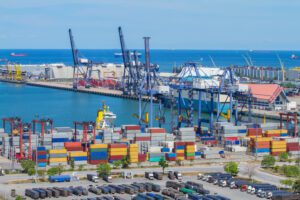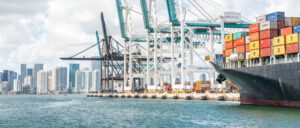Nearshoring: A Strategic Manufacturing Necessity Even Before Trump’s Election
In an era of constant threat of disruption, nearshoring has moved from a “nice-to-have” to a strategic imperative for global manufacturers. For decades, offshoring was commonplace; companies raced to operate and/or source from the best-cost locations worldwide, relying on a stable, connected global manufacturing landscape and economy. But recent geopolitical upheavals, regulatory shifts, climate related weather shocks and post pandemic-triggered supply chain crises have changed the game entirely.
Today, the focus is squarely on resilience, flexibility and proximity to core markets. A time of exponential change has come to the global manufacturing landscape and companies are future-proofing their operational footprint. Manufacturers are reconsidering the value of location, placing operations closer to customers and suppliers, as the drivers of global manufacturing competitiveness continue to evolve.
With the outcome of the U.S. Presidential election and the anticipation of new tariffs in the coming year, Roland Berger’s research indicates that nearshoring has shifted from a strategic choice to a critical necessity. Market expectations of significant tariffs could translate into substantial economic impacts, affecting operational costs and supply chain structures. According to Roland Berger’s studies, nearshoring can mitigate these risks by reducing tariff exposure and creating excellent supply chain stability, enabling U.S. companies to manage costs more effectively while building a more resilient and agile manufacturing footprint.
This shift presents a distinct competitive advantage. Companies that commit to North American production benefit from avoiding tariff volatility and shorter supply chains, faster response times and better alignment with market demands. Roland Berger’s frameworks suggest that companies embracing nearshoring are better positioned to adapt to policy shifts and secure long-term growth. In this environment, proximity, resilience and flexibility are essential drivers for future-proofing operations and maintaining competitiveness.
The new reality has elevated nearshoring as a top priority. A recent Roland Berger study conducted with Manufacturers Alliance found that 74% of companies are expanding or piloting localization initiatives—a striking indicator of how rapidly the tide is turning. U.S. manufacturing investments have surged, growing 2.3X since 2022, with Mexico emerging as a prime destination. This shift is already reshaping the competitive landscape, as the U.S. imports more goods from Mexico than China. While Mexico can be an attractive option for nearshoring, recent factors like labor shortages, inflation and tariffs have introduced new complexities. There’s no silver bullet—companies must evaluate multiple elements as well as future scenarios to determine a comprehensive footprint strategy that captures long-term strategic advantage.
|
|
| 11/18/2024 | Michelle Drew Rodriguez | Industry Week |
|
|
China’s Overcapacity May Become a Southeast Asia Problem if Trump’s Tariffs Materialise |
Southeast Asia is already bracing for a wave of tariffs. Donald Trump’s return to the White House brings a significant shift in US trade policy, with his proposed sweeping tariffs threatening to trigger retaliation and raising the prospect of a global trade war.
For a region whose exports to the US surged to US$143 billion in the first half of 2024 – overtaking shipments to China – Southeast Asia will likely come under increased scrutiny.
At the heart of Trump’s agenda is rebalancing trade through robust tariff increases, which he views as both a powerful negotiating tool and a means to rejuvenate American manufacturing. On Tuesday (Nov 19), Trump announced China hawk Howard Lutnick as his pick for commerce secretary, tasking him with leading the administration’s trade and tariff strategy.
On the campaign trail, Trump said he would impose tariffs of up to 20 per cent on all imports and a staggering 60 per cent or more on Chinese goods – which would effectively shut many Chinese exports out of the US market.
Southeast Asian economies such as Vietnam, Thailand and Malaysia export more to the US than they import, creating significant trade surpluses. Tariffs would raise the cost of their exports making them less attractive to American buyers. To maintain access to the critical US market, they may need to increase imports of American goods and curtail exports.
ASEAN economies could face short-term disruptions, with economists projecting that Trump’s tariffs could cut regional growth by up to 0.5 percentage points in 2025.
CHINA’S OVERCAPACITY – ASEAN’S NEW PROBLEM?
But Chinese exports that are shut out of the US market need to go somewhere else. While this might be good news for consumers in the short term, Southeast Asian manufacturers are already struggling with Chinese industrial overcapacity.
Thailand, for example, has seen over 2,000 factory closures this year due to a flood of cheap Chinese steel and other goods. Indonesia’s textile sector has lost tens of thousands of jobs in just six months, and local manufacturers across the region are struggling to stay competitive.
If tariffs cut off access to American buyers, this challenge could deepen as subsidised Chinese imports flood Southeast Asia and other emerging markets.
ASEAN governments are already taking steps to curb the influx. Vietnam and Indonesia have imposed a range of anti-dumping tariffs on Chinese goods, and Thailand recently announced measures to monitor cheap imports.
But countries will also need to strengthen enforcement mechanisms, improve quality standards, and expand the use of anti-dumping and countervailing duty measures to ensure fair trade.
Read the Full Commentary Here
|
Trade Policy Shifts and Their Potential Implications for U.S. Agricultural Exports |
Following is an excerpt. The full piece is linked below, and here.
Over the past eight years, concerns about unfair competition and national security related to imports from China have increasingly shaped U.S. trade policy. Lawmakers have expressed growing alarm over China’s trade practices, which they argue undermine American industries and pose substantial threats to national security. These concerns have led to renewed calls to revoke China’s PNTR status, which would significantly increase tariffs on all Chinese imports. Such a shift would dramatically escalate the ongoing trade tensions between the two nations, potentially leading to widespread economic repercussions. In May 2024, the White House took a decisive step by imposing new tariffs on a range of Chinese products, including critical sectors such as electric vehicles and semiconductors. This action, reminiscent of previous administration policies, reflects a broader trend toward protectionism in U.S. trade policy. Presidential candidates have echoed this sentiment, proposing even more aggressive measures, including broad-based tariff increases on all U.S. imports. These developments signal a potential return to the intense trade conflicts of recent years, with far-reaching implications for U.S. agriculture.
Historically, U.S. trade policies that target China have triggered swift and severe retaliatory measures from Beijing. The 2018-2019 trade conflict is a prime example, where China responded to U.S. tariffs with significant retaliatory tariffs on American agricultural products . This response had a major impact on U.S. agriculture, particularly in the Midwest, where the economy heavily depends on agricultural exports. The soybean industry sets a noteworthy example, as it relies heavily on the Chinese market. Reduced demand from China led to lower export prices and increased competition from other countries, most notably Brazil. The consequences were severe, with many U.S. farmers facing significant financial losses. The potential for a repeat of these events is now a primary concern for the U.S. agricultural sector. As new trade policies are proposed, the risk of further retaliatory tariffs looms large, threatening to disrupt markets again and cause substantial economic harm to U.S. agriculture.
The proposed U.S. trade policies under consideration could have profound implications for the agricultural sector, particularly if they provoke retaliatory tariffs from China. To understand the potential impacts, we consider three primary scenarios that reflect varying levels of tariff increases and corresponding retaliatory measures. In the first scenario, the U.S. Executive Branch imposed a 17.5% to 75% increase in import tariffs on select Chinese goods, including steel, aluminum, semiconductors, and EVs. In retaliation, China responds with a 20% tariff increase on U.S. agricultural products. This scenario assumes that no other countries will engage in retaliatory actions, making it a bilateral conflict between the U.S. and China. The second scenario advocated by the Republican presidential candidate is more complex and is divided into two sub-scenarios. Scenario 2.a involves the U.S. imposing a 10% tariff increase on all goods from all countries, prompting a global retaliatory response with similar tariff increases on U.S. agricultural exports. Scenario 2.b escalates the situation further, with a 60% tariff increase on Chinese goods and a 10% increase on goods from other countries, leading to severe global trade disruptions.
The third scenario presents a slightly different approach, focusing on the potential revocation of China’s PNTR status by the U.S. Congress. This action would result in a 9.5% increase in U.S. tariffs on Chinese agricultural goods, with China likely responding with an equivalent 9.5% tariff increase on U.S. agricultural exports in a tit-for-tat scenario. Unlike the previous scenarios, this one does not involve broader global retaliation, instead concentrating on the bilateral trade relationship between the U.S. and China. Each scenario in our analysis provides a detailed framework for estimating the potential export losses U.S. agriculture might face, particularly focusing on key commodities such as soybeans, corn, beef, and wheat. Understanding the scale and distribution of these potential impacts can help inform strategies to mitigate the adverse effects of these brewing trade disputes.
09/11/2024 | Sandro Steinbach, Yasin Yildirim & Carlos Zurita | Farmdoc Daily
How Supply Chains Fuel Transnational Conflict in the Middle East
|
Conflicts in the Middle East are increasingly ‘transnational’, spreading beyond national borders and becoming intertwined with regional and global trade.
Governments and formal institutions collaborate with informal traders and armed groups to operate both legal and illegal supply chains – moving people, capital and goods along routes across Iran, Iraq, Türkiye, and the Levant.
One grouping associated with these regional dynamics is the Axis of Resistance, which views its role as opposing Israeli and US ‘imperialism’ in the Middle East.
The Axis connects Iran, Hezbollah in Lebanon, the Popular Mobilisation Forces (PMF) in Iraq, the Assad regime in Syria, Hamas in Gaza, and the Houthis in Yemen. Another example is the Kurdistan Workers’ Party (PKK) which pursues its nationalist armed struggle against the Turkish state across Iraq, Syria and Türkiye.
Groups like the Axis of Resistance blur the line between licit and illicit activity, and state and non-state actors, because they operate in and influence both formal and informal government institutions. They are part of the decision-making structures of multiple states in the region, including Lebanon, Syria, Iraq, Iran, and Yemen.
This article examines how these groups operate and gain power from cross-border trade using three case studies: the supposedly ‘legal’ tomatoes supply chain, the ‘illegal’ narcotics supply chain, and the dynamics around two key Iraqi conflict ‘hubs’ – the towns of al-Qaem and Rutba.
The article also explains how the use of military strikes and sanctions has failed to reduce conflict or illegal trade and has instead disproportionately harmed local populations.
Understanding these supply chains offers a crucial insight into the true power dynamics that connect the Middle East.
11/18/2024 | Hayder Al-Shakeri & Dr Renad Mansour | Chatham House




